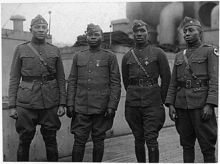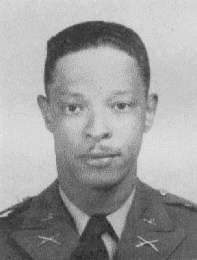366th Infantry Regiment (United States)
The 366th Infantry Regiment was an all African American (segregated) unit of the United States Army that served with distinction in both World War I and World War II. The unit was one of the exceptional Negro units with all black officers and personnel; the U.S. military did not desegregate until after World War II, and in most of the segregated units, all field grade and most of the company grade officers were white. During World War II, the unit saw combat in Italy as part of the 92nd Infantry Division (colored), 5th Army.
| 366th Infantry Regiment | |
|---|---|
| Active | 1917–1919 1940-1945 |
| Country | |
| Branch | United States Army Reserve |
| Type | Infantry |
| Size | Regiment |
| Garrison/HQ | Fort Devens, Massachusetts |
| Motto(s) | "Labor Conquers All Things." |
| Engagements | World War I, World War II |
| Battle honours | Meuse-Argonne Offensive, Rome-Arno Campaign |
U.S. Infantry Regiments | |
|---|---|
| Previous | Next |
| 365th Infantry Regiment | 367th Infantry Regiment |
World War I

The 366th Infantry was constituted 16 August 1917 in the National Army as the 366th Infantry and assigned to the 92nd Division and organized at Camp Dodge, Iowa, in November 1917.
In World War I the regiment served overseas as a part of the 92nd Division, National Army and earned credit for battle participation as follows:
- St. Die Sector (Lorraine), 23 August 1918 – 20 September 1918
- Meuse-Argonne Sector, 26 September 1918 – 5 October 1918
- Marbach Sector (Lorraine) 8 October 1918 – November 1918
The 366th Infantry was demobilized 25 March 1919 at Fort Oglethorpe, Georgia, and reconstituted 16 December 1940 in the Regular Army.
World War II
It was activated 10 February 1941 at Fort Devens, Massachusetts and assigned to the Eastern Defense Command on 30 April 1942.
- Attached to the 1st Service Command on 1 May 1943 and to the XIII Corps on 1 September 1943.
- Moved to A. P. Hill Military Reservation, Virginia 14 October 1943 and to Camp Atterbury, Indiana 23 November 1943 under XX Corps.
- Assigned XXII Corps 21 January 1944 and staged at Camp Patrick Henry, Virginia 22 March 1944 until it departed Hampton Roads P/E (Point of Embarkation) 28 March 1944.
- Arrived North Africa 6 April 1944 and attached to 15th Air Force Service Command for airfield security duties from Sardinia to the Adriatic coast.
- Assigned to Fifth Army 4 November 1944 and arrived Livorno, Italy 21 November 1944 for attachment to the 92nd Infantry Division until 25 February 1945.
- Disbanded in Italy on 28 March 1945 and personnel transferred into the 224th and 226th Engineer General Service Regiments.
Combat chronicle
Colonel Howard Donovan Queen was the commanding officer (CO) at the time of embarkation in March 1944. Although the 366th Infantry had been at "combat readiness", after a prolonged period which was devoted only to guard duty, Queen felt that they needed at least three months for preparation to be "combat ready". Queen wrote a significant request for withdrawal from active command and included his guarded reservations in regard to his deeply held tenets. In spite of this it was decided in November 1944 to attach the 366th Infantry to the 92nd Division.
After continuing poor combat performance including many instances of unauthorized withdrawals upon meeting the enemy, low morale and malingering, the 92nd Infantry Division was considered of inferior quality both by German and American commands and fit for only defensive roles. Things deteriorated to the point that the division was withdrawn from the lines and rebuilt in early 1945 with the removal of the 366th Infantry Regiment (formed into two engineer general service regiments) and the addition of the 473rd Regiment and the highly decorated Nisei 442nd Regiment, made up of Japanese Americans, which was withdrawn from the fighting in France to bolster the division’s combat effectiveness.
Notable veterans

- Edward W. Brooke III: First African American after Reconstruction elected to the United States Senate.
- Frederic E. Davison: first African American US Army Major General and division commander
- William L. Dawson: First African American to chair a committee in the United States Congress (1949) (World War I veteran)
- Aaron R. Fisher: Distinguished Service Cross recipient, World War I
- John R. Fox: Medal of Honor (posthumous) recipient, World War II
- James F. Hamlet: second African American US Army Major General
General
The 366th Infantry Regiment was awarded two campaign streamers for the Colors; the first for Meuse-Argonne Lorraine (September 1918 to November 1918), and the second for Rome-Arno (January 1944 to September 1944).
The Regimental Shield incorporated the Cross of Lorraine. The Regimental Motto was, "Labor Conquers All Things."
References
- Edward Brooke (2006). Bridging The Divide: My Life. Rutgers University Press. ISBN 0-8135-3905-6. Retrieved 21 November 2006.
- Elliott V. Converse III (1997). The Exclusion of Black Soldiers from the Medal of Honor in World War II. McFarland & Company. ISBN 0-7864-0277-6.
- Truman K. Gibson, Jr. (2005). Knocking Down Barriers: My Fight for Black America. Northwestern University Press. ISBN 0-8101-2292-8.
- Hondon B. Hargrove (1985). Buffalo Soldiers in Italy: Black Americans in World War II. McFarland & Company. ISBN 0-89950-116-8.
- Ulysses Lee (2000) [1966]. "XIX - Mountain and Plain". The Employment of Negro Troops. United States Army Center of Military History. CMH Pub 11-4 and LCC 66-60003.
- James A. Sawicki (1981). Infantry Regiments of the U.S. Army. Wyvern. p. 522. ISBN 0-9602404-3-8.
- Shelby L. Stanton (1984). Order of Battle, U. S. Army, World War II. California Presidio Press. p. 252. ISBN 0-88365-775-9.
- Harrold E. Russell, Jr. (2008). Company I 366th Infantry. RoseDog Books. p. 34. ISBN 978-0-8059-8992-2.
_troops_return_colors_to_Union_League_Club._Men_draw_._._._-_NARA_-_533590.tif.jpg)